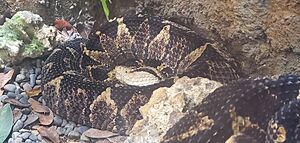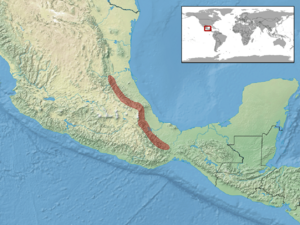Mexican jumping pitviper facts for kids
Quick facts for kids Mexican jumping pitviper |
|
|---|---|
 |
|
| Conservation status | |
| Scientific classification | |
| Genus: |
Metlapilcoatlus
|
| Species: |
nummifer
|
 |
|
| Synonyms | |
|
|
The Metlapilcoatlus nummifer, often called the Mexican jumping pitviper or jumping viper, is a venomous snake found only in Mexico. It is a type of pit viper, known for its special heat-sensing pits.
Contents
About the Jumping Viper
This snake is known for its short, thick body. Adult jumping vipers usually grow to be about 18 to 24 inches (45 to 60 cm) long. Their snout, which is the front part of their head, is rounded. They have a sharp ridge above their eyes called a canthus.
Scales and Skin Patterns
The jumping viper has special scales on its body. Around the middle of its body, it has 23 to 27 rows of scales on its back. These scales are strongly keeled, meaning they have a ridge down the middle. In larger snakes, these scales can feel bumpy.
On their belly, they have 121 to 135 scales. The scales under their tail, called subcaudals, number 26 to 36 and are mostly single. Their eyes are separated from their lip scales by three to four rows of small scales.
The snake's color can be tan, light brown, or gray. It has about 20 dark brown or black diamond-shaped blotches on its back. The bottom parts of these blotches often connect with spots on its sides. This forms narrow bands across its body. The top of its head is dark. It has dark stripes that go from behind its eyes. The sides of its head below these stripes are lighter. Its belly is usually whitish, sometimes with dark brown spots.
Sometimes, people confuse these snakes with young bushmasters (Lachesis muta). However, jumping vipers do not have a special tail tip like bushmasters do. This makes them easy to tell apart.
Where the Jumping Viper Lives
The Mexican jumping pitviper lives in eastern Mexico. You can find it from San Luis Potosí towards the southeast. It lives on the Atlantic side of Mexico, in low-lying areas.
Habitat and Altitude
These snakes live in different kinds of forests. This includes cloud forests and rain forests. They can be found at altitudes from about 40 to 1,600 meters (130 to 5,250 feet) above sea level.
When this snake was first discovered, its exact home was not known. Later, it was confirmed to be in Mexico. Specifically, Teapa, Tabasco, Mexico, was suggested as a key location. Other similar snakes, Metlapilcoatlus mexicanus and Metlapilcoatlus occiduus, were once thought to be types of this snake.
Conservation Status
The Mexican jumping pitviper is listed as "Least Concern" (LC) by the IUCN. The Red List of Threatened Species helps us know which animals are safe and which are in danger.
Why it's "Least Concern"
A species is listed as "Least Concern" if it is found over a wide area. It also means there are many of them, or their numbers are not dropping quickly. For the jumping viper, its population is stable. This means its numbers are not going down. The last time its status was checked was in 2007.


